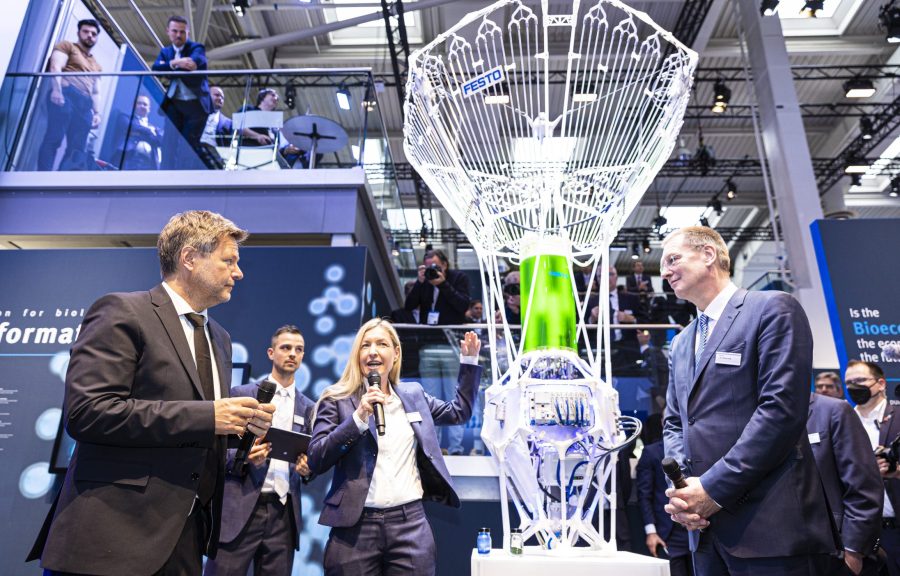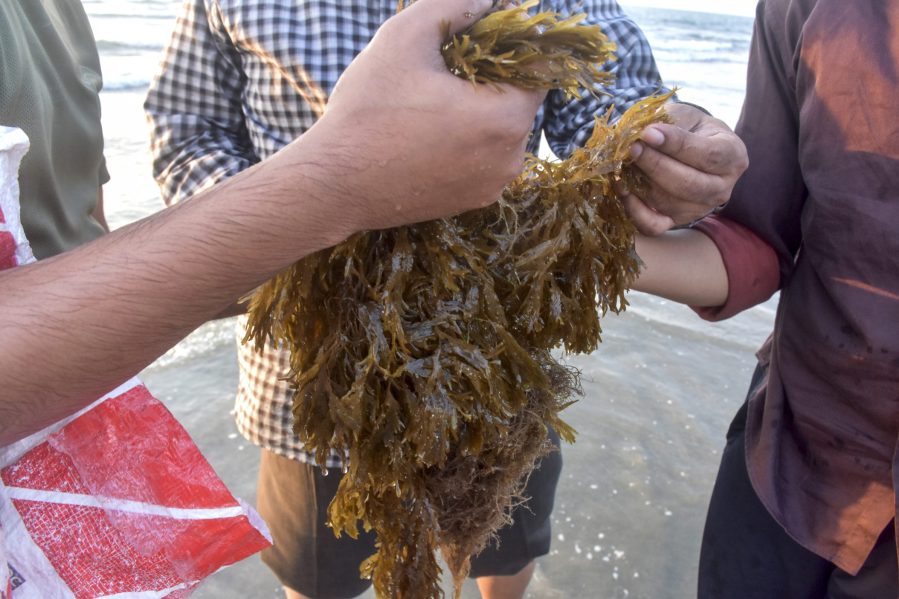Fuel Cells Are Similar to Batteries but Require a Continuous Source of Fuel

Billions of years ago, some of Earth's first life, tiny prokaryotic marine organisms called cyanobacteria (blue-green algae), utilized the process of photosynthesis- converting sunlight and carbon dioxide (CO2) into energy and biomass. The byproduct was oxygen and these tiny organisms were responsible for the oxygenation of Earth's atmosphere. Flash forward to today and there are more than 30,000 known species of algae, of which 1,000 have been researched as potential sources for producing biofuels a.k.a renewable fuels. Algae biofuel in particular could be a promising alternative to fossil fuels as humanity transitions to more sustainable methods of living.
These days we derive the majority of our fuel from underground crude oil (petroleum) deposits. This fuel was created over millions of years when the remains of marine organisms (mostly single-celled algae and bacteria) were buried beneath layers of sediment and rock, heat and pressure transforming them into rich deposits of hydrocarbons that can be burned as a source of energy—hence, the name "fossil fuels." Unfortunately, there are several problems with this fuel source. Petroleum is nonrenewable because it cannot be replaced at the rate at which we use it. Burning this fuel also presents the problem of releasing large amounts of CO2 into the atmosphere, warming and destabilizing Earth's climate.
Alternative, sustainable sources of energy are needed. Fossil algae is the fuel source of the past—but could living algae biofuel be the sustainable fuel source of the future?

How Is Algae Grown?
Algae can grow in fresh or saltwater environments. There are three main methods for cultivating algae for biofuels: the open pond system, the closed-loop system, and photobioreactors.
In the simple open-pond system, algae are grown in open-air ponds beneath warm sunlight. Like with other crops, however, a monoculture of algae is especially vulnerable to viral infections.
The closed-loop system addresses the problem of algae contamination by placing algae in clear plastic bags, which provides both exposure to sunlight and protection from contaminants. This system also produces algae more quickly and efficiently than the open-pond system.
Algae can also be grown in borosilicate glass tubes called bioreactors, which when exposed to sunlight can grow algae with maximum output and control. The algae grown in bioreactors can even be harvested daily. However, this is the most expensive method of growing algae for biofuels.
All of the methods mentioned above allow algae to be refined into various biofuels- biodiesel, green diesel, butanol/biogasoline, and methane. Each of these biofuels have different refinement processes and uses.
Biodiesel From Algae
Biodiesel is the second-most produced and used type of biofuel in the United States. Biodiesel has typically been created from vegetable oils and animal fats, and is blended with petrol-diesel for use in diesel engines. Similar to the production of vegetable oils, the lipids (fats and oils) from algae biomass can be converted into biodiesel through a process called transesterification—in which the feedstock (raw material, in this case, algae biomass) reacts with an alcohol (such as methanol) and a catalyst (like lye), producing glycerin and biodiesel. This type of biodiesel, regardless of its source, is called B100.
Green Diesel
Green diesel or renewable diesel (R100) is different from regular biodiesel because it is chemically identical to petrol-diesel. So, it can be used as a substitute for petrol-diesel without being blended with petrol-diesel. Green diesel is produced through hydrocracking, which breaks down molecules into shorter chains of hydrocarbons. This type of green biodiesel from algae is especially promising because if produced in great enough quantities, it could replace petrol-diesel altogether.
Butanol and Biogasoline
Butanol is a biogasoline, or a compound that can be substituted for gasoline. The carbohydrates leftover from extracting oil from algae can be used to produce butanol, which has an energy density 10% less than gasoline, greater than methanol or ethanol. Butanol can be produced from algae through the fermentation. Butanol has the potential to be used as an alternative to gasoline in internal combustion engines.

What are the Advantages of Algae Biofuel?
As photosynthetic organisms, algae contribute 40% of global carbon fixation, meaning that they draw a large amount of CO2 from the atmosphere. That also means that fuel production from algae could be a relatively carbon-neutral source of energy—even as algae biofuels are burned and release CO2, large algae crops could sequester that carbon and recycle it to create more biofuels. In the process, they would also release oxygen into the atmosphere.
Algae can be grown on non-arable land that does not support farming; they also require less space than traditional crops. They can even be grown in saltwater or potentially waste-water or contaminated water.
Because algae replicate and produce biomass very quickly, and there are numerous algae species and great genetic diversity among them, genetic research and modification have the potential to rapidly improve strains.
Finally, algae biofuels are biodegradable and non-toxic because they do not contain sulfur.
What Are the Challenges Of replacing fossil fuels?
Replacing fossil fuels with algae biofuels presents numerous hurdles. Beginning with cultivation- the first challenge is engineering a system that maximizes efficiency and is inexpensive enough for large-scale algae farming—photobioreactors are expensive, but open pond systems are not as efficient.
Despite the potential for growing algae on land or in waste or saltwater, there would still be significant space needed for the development of these production facilities. The amount of water required is also a potential limiting factor.
Another significant challenge lies with the nutrients required for algae growth, such as phosphorus, nitrogen, and potassium. Others like iron (for marine algae) and sulfur must also be considered. One potential solution is to recycle nutrients by using waste-water or agricultural runoff by algal facilities. Another is utilizing the process of anaerobic digestion, which produces bacterial slurry for fertilizer in addition to methane gas. Methane, a primary component of natural gas, might then be used as an energy source.
The next hurdle is creating cost-effective oil extraction strategies. The current popular methods for oil extraction are oil pressing, hexane extraction, and supercritical CO2 fluid extraction- all of which are expensive. Once this hurdle is overcome, however, crude algae oil is similar enough to crude petroleum oil that it could be processed with slight improvements upon existing infrastructure.
Finally, algal biofuels simply are not as economically attractive to major fuel companies due to a lack of research and existing infrastructure, despite the fact that they would be much less environmentally damaging than fossil fuels. Production of co-products from algae such as cosmetic and pharmaceutical ingredients may help to offset some expenses, but the bottom line is that algae biofuel remains a tough sell for those who desire economic gain in the short-term.
Humanity owes everything to microorganisms like algae and bacteria from the air we breathe to the fuel we burn. While algae biofuel offers multiple benefits as a clean energy source, there are obstacles that must be overcome in order to produce it on a large scale. Yet, as humanity looks for solutions to climate change, developing these sustainable energy sources- algae biofuel and solar, wind, and water fuel sources – will play a key role to help mitigate the damage done to our planet.
Source: https://www.reference.com/science/is-algae-biofuel-the-sustainable-fuel-source-of-the-future?utm_content=params%3Ao%3D740005%26ad%3DdirN%26qo%3DserpIndex&ueid=00dc7db7-d107-4a5f-a437-ee350df952ea
0 Response to "Fuel Cells Are Similar to Batteries but Require a Continuous Source of Fuel"
Postar um comentário